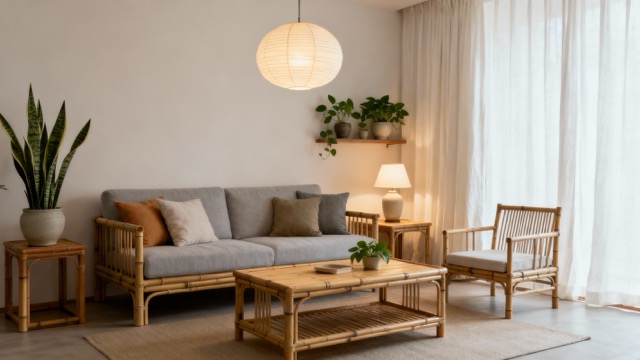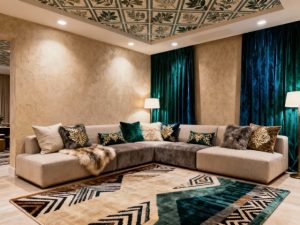Introduction
In a world overflowing with choices and possessions, a quiet revolution is happening in our homes. Japandi—a design philosophy that merges the clean lines and functionality of Scandinavian minimalism with the warm, nature-inspired tranquility of Japanese aesthetics—is redefining what it means to create a sanctuary.
Unlike harsh minimalism that can feel cold and sterile, Japandi brings warmth into simplicity. It’s about thoughtfully curating your space so that every piece serves a purpose, every color soothes the soul, and every room feels like a gentle embrace.
At TradeFurnish, we believe your home should tell a story of peace and purpose. Let’s explore how to craft your own Japandi sanctuary.
What is Japandi Design?
Japandi is more than just a buzzword—it’s a philosophy that celebrates the beauty of restraint while honoring comfort and connection.
Scandinavian roots contribute:
Minimalism and functionality
Natural materials (light woods, linen, wool)
Clean lines and uncluttered spaces
Emphasis on light and airiness
Japanese principles bring:
Wabi-sabi (beauty in imperfection)
Zen minimalism
Natural textures and earthy tones
Harmony with nature
Mindful living spaces
When combined, these create homes that are both visually serene and emotionally comforting.
The Color Palette: Neutral, Warm, and Inviting
Japandi spaces typically feature a carefully considered palette of neutrals with warmth baked in.
Core Colors:
Soft whites and creams – For walls and larger furniture pieces, these provide a clean canvas
Warm grays and taupes – Add subtle depth without visual noise
Natural wood tones – Bamboo, ash, light oak bring organic warmth
Muted earth tones – Soft terracotta, warm sand, gentle green accents
Accent Colors (used sparingly):
Charcoal gray for grounding
Deep forest green for connection to nature
Soft sage or dusty blue for calming touches
The key is restraint. Colors work together to create a cohesive, calming environment rather than competing for attention.
Essential Furniture Elements
Japandi furniture prioritizes simplicity, functionality, and natural materials.
Living Room:
Low-profile seating with clean lines
Bamboo or ash wood frames
Linen or light canvas upholstery
Minimalist side tables in light wood
Floor cushions for flexible seating
Bedroom:
Low platform bed frame (inspired by Japanese design)
Natural wood nightstands
Minimal decorative elements on surfaces
Quality linen bedding in soft tones
Dining Area:
Simple wooden dining table
Unadorned chairs with natural finishes
No unnecessary centerpieces—maybe a single potted plant
Hallmarks of Japandi furniture:
Visible wood grain and natural variations
Absence of ornate details
Sturdy, long-lasting construction
Multi-functional pieces (storage beds, nesting tables)
Raised slightly from the floor for airiness
Textiles: The Soul of Japandi Comfort
While minimalism might suggest bare floors and windows, Japandi textiles add warmth and texture through natural fibers.
Curtains & Drapes:
Linen curtains in natural white or cream allow soft, diffused light
Light cotton blends maintain simplicity while softening sunlight
Floor-to-ceiling lengths create elegance without fuss
Minimal hardware (bamboo rods, simple metal clips)
Rugs:
Natural jute or sisal for texture
Wool area rugs in neutral tones
Layered rugs create subtle dimension
Geometric patterns (simple, not busy)
Cushions & Throws:
Organic cotton pillow covers
Linen cushions with subtle texture
Wool throws in cream or gray
Minimal color variation—harmony over contrast
Bedding:
Egyptian cotton or organic linen sheets
Natural dye colors (soft whites, creams, warm grays)
Minimal embellishment
Quality over quantity
At TradeFurnish, our collection of linen curtains, natural jute rugs, and organic cushion covers are designed specifically for Japandi spaces. Each piece is crafted to age beautifully and improve with time.
Bringing Nature Indoors: Plants and Natural Elements
Japandi celebrates the connection between interior and nature.
Indoor Plants:
Large potted ferns or bamboo for vertical interest
Simple ceramic or clay pots (unpainted for purity)
Placed in corners or near windows
Grouped in odd numbers for natural balance
Natural Materials:
Exposed wooden beams (if possible)
Stone or concrete elements (keeping them minimal)
Raw wood shelves and accents
Natural fiber baskets for storage
Water Elements:
Small indoor fountains or water features
Rock displays inspired by Japanese gardens
Maintaining a sense of flow and balance
Lighting: Soft, Warm, and Functional
Japandi lighting is never harsh or overly decorative.
Best Lighting Choices:
Warm white bulbs (not cool white)
Minimalist fixtures – simple geometric shapes, natural materials
Paper lanterns – inspired by Japanese design
Floor lamps with simple linen or paper shades
Natural daylight through large windows with simple curtains
Avoid:
Ornate chandeliers
Bright overhead lighting
Multiple competing light sources
Metallic or glitzy finishes
Space Planning: Creating Calm Through Organization
Japandi spaces feel peaceful because they’re thoughtfully organized.
Key Principles:
Negative space is your friend – Empty walls and floor space create calm
Everything in its place – No visual clutter
One focal point per room – Maybe a beautiful plant, a piece of art, or a window view
Open sight lines – Furniture arranged to create flow, not obstruction
Hidden storage – Baskets, cabinets, and drawers keep belongings out of sight
Room-by-Room Japandi Inspiration
Common Japandi Mistakes to Avoid
Too much brown – Balance warm wood with cool neutrals
Overcrowding with plants – A few strategic plants, not a jungle
Mixing too many wood tones – Stick to 1-2 wood species
Ignoring texture – Layers of subtle texture create interest
Going completely bare – Japandi is minimal, not cold
Artificial elements – Stick to natural materials
Too many accent colors – Restraint is key
Styling Tips for a Cohesive Look
Start with one room – Master bedroom or living room—learn the style before expanding
Invest in quality basics – Neutral furniture that will last
Add layers gradually – Plants, textiles, and art over time
Edit ruthlessly – If it doesn’t serve a purpose or bring joy, it doesn’t belong
Embrace imperfection – Wabi-sabi celebrates the beauty of natural wear
Keep it clean – Minimal clutter is essential to the aesthetic
TradeFurnish Products Perfect for Japandi
Our carefully curated collections support the Japandi aesthetic:
Linen Blend Curtains – Soft, diffused light in natural tones
Jute & Cotton Rugs – Natural textures that ground spaces
Organic Cotton Bedsheets – Pure, minimalist comfort
Natural Linen Cushion Covers – Layers of subtle texture
Bamboo-inspired Textiles – Supporting the organic feel
Each product is designed to complement the Japandi philosophy of quality, simplicity, and natural beauty.
Conclusion
Japandi is more than interior design—it’s a lifestyle choice. It’s about creating spaces that support well-being, reduce stress, and foster mindfulness. In a world that often feels chaotic, Japandi homes offer sanctuary.
The beauty of this style lies not in complexity, but in the careful curation of simple, functional, beautiful pieces that work in harmony. It’s minimalism with a warm heart.
Start your Japandi journey today. Begin with one room. Choose natural materials. Edit your possessions. Bring in plants. And slowly, watch your space transform into the peaceful, intentional home you’ve always wanted.
Because at TradeFurnish, we believe your home should be your sanctuary.



